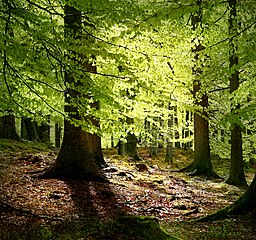Gribskov
| Gribskov | |
| Forest | |
|
Old beech trees in Gribskov.
|
|
| Official name: Gribskov | |
| Name origin: The common forest | |
| Country | Denmark |
|---|---|
| Region | Capital Region of Denmark |
| District | North Zealand |
| Municipality | Gribskov, Hillerød |
| Part of | Scandinavia |
| City | Hillerød, Helsinge, Fredensborg |
| Landmark | The lakes of Store Gribsø, Solbjerg Engsø, Strødam Engsø |
| Building | Gribskovbanen, Skovskolen, Esrum Abbey |
| Area | 56 km2 (22 sq mi) |
| Biome | coniferous forest, mixed deciduous forest, semi-natural beech wood |
| Geology | moraine hills |
| Plant | beech, European larch, oak, etc. |
| Animal | deers |
Gribskov (Grib Forest) is Denmark's fourth largest forest, comprising c. 5,600 ha of woodland situated in northern Zealand, west and south of Lake Esrum. The forest is owned and administered by the State of Denmark. In July 2015, it was one of three forests included in the UNESCO World Heritage Site, The par force hunting landscape in North Zealand.
Gribskov is usually divided into four sections: The northwest surrounding the small village of Maarum, the northeast on the banks of Lake Esrum, the southwest around the small lake of Gribsø and finally the southeast, enclosing the village of Nødebo on the southern banks of Lake Esrum.
Only a thin strip of Hillerød town in the south separates Gribskov from many larger woodlands such as Store Dyrehave at 1,100 ha, Tokkekøb Hegn at 631 ha and several smaller woods.
The Danish name Gribskov translates literally as Grib forest in English. The first part, 'grib', is the imperative form of the verb for 'catch' or 'grab', but the actual meaning and etymology of the word go a bit deeper. 'Grib' refers to the Old Danish word for something 'without any specific owner', so 'Gribskov' actually means a woodland of common ownership.
Gribskov and Lake Esrum are designated as EU habitat directive and Natura 2000 areas, as part of an even larger preserve. On top of that, Gribskov is designated as an Important Bird Area (IBA). Around 20% or c. 1,200 ha of the forest has been reserved as 'forest to be untouched', in an effort to preserve some of the few spots of semi-natural woodland (SNW) in Denmark and stimulate the growth of new.
...
Wikipedia

